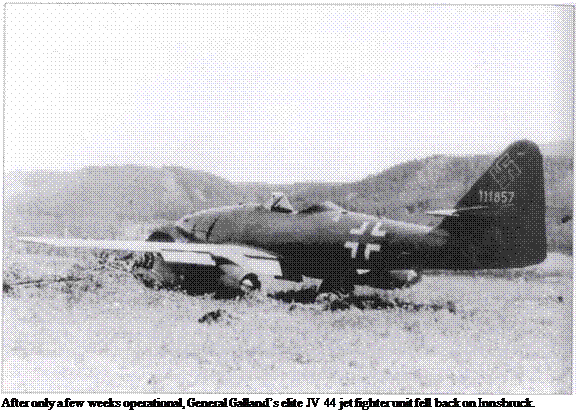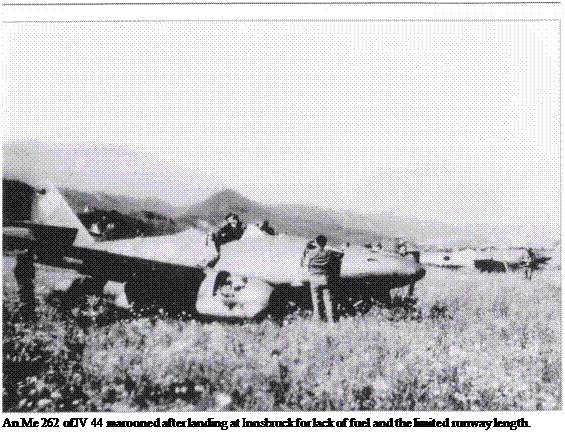Production Problems
The first Me 262 A-la series aircraft were built for test purposes at the Messerschmitt Works, Augsburg Haunstetten, from March 1944. Five prototypes had been constructed first, Me 262 S-l to S-5, and then S-6 to S-10 and the first Me 262 A-las at Leipheim. As assembly there was threatened by air attack, a large complex was set up in woods at Horgau. These were large, well camouflaged hangars, screened by numerous trees, and in a short time the production lines were running smoothly, as was also the case for the final assembly at Hasenbiihl near Schwabisch Hall. By the end of July 1944, 99 completed Me 262s had been turned out.
The Jagerstab conference of 22 July 1944 ordered that production must be accelerated in order to fulfill more of the Luftwaffe requirement. More factories

were erected such as the Donau Moorkultur AG at Neuburg/Danube or REIMAG at Kahla. A gigantic underground production facility was set up in the nearby Walpersberg in 1944. On the ridge of the mountain was an airstrip accessible by a precipitous cable-lift from the mountain flank. A new assembly centre for parts was built in Brandenburg-Briest by November 1944 while production and assembly shops sprang up at Berlin Staaken, Wenzdorf/ Hamburg, Eger/Bohemia, at Memmingen and Kitzingen. The most brutal methods were employed to construct the gigantic production bunkers at Kaufering and Gusen in record time using innumerable concentration camp inmates. Regardless of the countless casualties, by 31 December 1944 568 Me 262 A-ls and A-2s had been turned out. Because of numerous breakdowns and losses during transfers to the front-line units, only a limited proportion arrived. Meanwhile failures in the electricity supply and problems with turbines and the shortage of parts began to show how threadbare things were becoming due to the incessant air raids. Little changed before the spring of 1945, and thus the dream of having several fighter Geschwader equipped with the jet by March

evaporated. Only at JG 7, KG(J) 54 and Blitzbomber Geschwader KG 51 were Me 262s present in numbers. In January 1945 the QM-General had 108 machines to distribute. Besides 15 for I./JG 7 and 11 for III./JG 7, 36 went to EKG(J), 2 to III./KG(J) 6, 6 to III./KG(J) 54, 3 to the Welter night-fighter commando and 8 to industrial protection flights (ISS 1 and 2).
Deliveries of the Me 262 A-la rose, but not to the levels hoped for. Only 155 aircraft became available for distribution in February. Of these, I. and II. Gruppen at JG 7 received 42, while KG(J) 54 acquired 58. One machine went to JV 44 and another to ferry Geschwader FIUG 1. In March 1945 JG 7 received about 75 new Me 262s and JV 44 ten. The other units had to make do with repairs.
Finally 85 Me 262 A-la training machines remained to be distributed. Besides ten apportioned to III./EJG 2, II./KG(J) 54 got 6, FIUG 1 and JV 44 had two each, Chief-TLR and III./JG 7 received one each. The remaining three were listed for II./EKG 1.
In April 1945 JG 7 and JV 44 took receipt of more than 50 Me 262s, but these were too few to equip all four Gruppen at JG 7. With the termination of
all work on the Bf 109, Fw 190 and Do 335 on 22 March 1945, Me 262 production was forced to the forefront. On Hitler’s order, all production, excepting the Ar 234 jet bomber, was now to be concentrated in the fighter sector. As a result of the war situation, the instruction was only met to a limited extent as work at Messerschmitt and Focke-Wulf on piston-engined fighters had to be completed before winding down, which would last several weeks. A statistical document issued by OKL shows delivery of all versions of the Me 262 from Blitxbomber% to fighters, reconnaissance aircraft and night fighters as at 10 April 1945:
|
JG 7 |
372 |
NFG11 |
19 |
|
KG 51 |
342 |
JV 44 |
13 |
|
KG(J) 54 |
163 |
KG(J)6 |
13 |
|
KdE |
25 |
||
|
Testing, industry and research |
59 |
||
|
Short-range reconnaissance Gruppen I and VI |
43 |
This was how at least 1,049 Me 262 A-ls, A-2s, B-ls and B-2s were distributed within the Luftwaffe. At the war’s end another 400 Me 262s were either ready for delivery, or virtually complete but lacking parts necessary for operational readiness. A further 500 were at a more or less advanced stage of construction. The shortage of engines, radio/radar equipment and increasingly MK 108 guns was making itself felt. J-2 fuel for delivery flights was also critical. The production of smaller jet fighters with a more powerful HeS 011 A-l jet turbine was therefore seen as a rational alternative to the Me 262 A-la.










